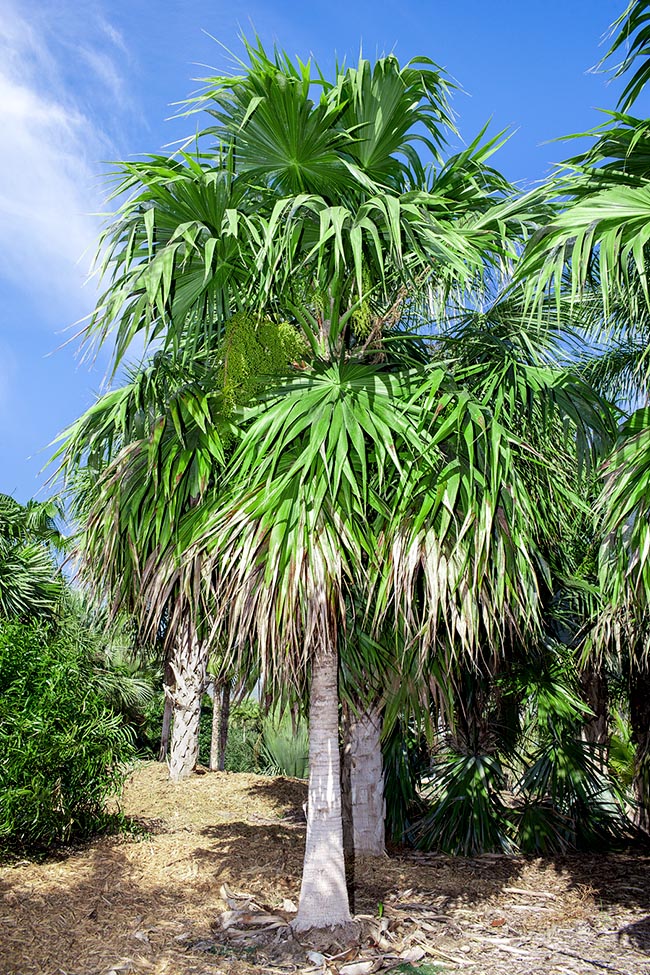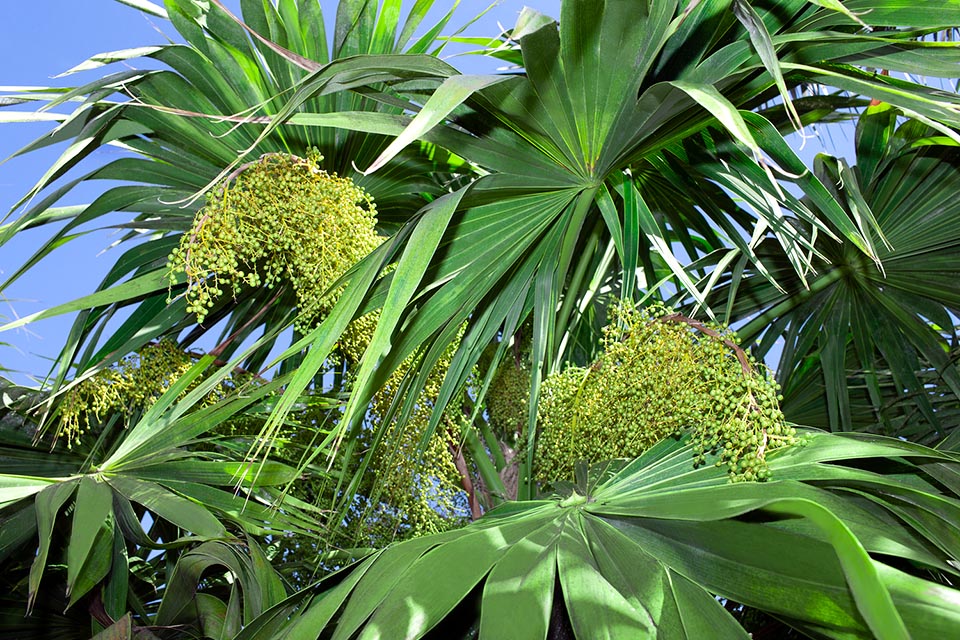Family : Arecaceae

Text © Pietro Puccio

English translation by Mario Beltramini

Native to Jamaica, where it grows in the deciduous forests on calcareous soils, poor, from the sea level up to about 1000 m of altitude, the Thrinax parviflora reaches 2-13 m of height with 5-15 cm of diameter © Giuseppe Mazza
The species is native to Jamaica where it grows in the deciduous forests on calcareous soils, poor, from the sea level up to about 1000 m of altitude.
The name of the genus comes from the Greek “θρῖναξ” (thrinax) = “three-tined pitchfork”, but also “shovel for riddling”, with probable reference to the palmate leaves; the specific name is the combination of the Latin adjective “parvus, a, um” = small and of the substantive “flos, oris” = flower, with obvious reference.
Common names: broom palm, mountain thatch palm, palmetto thatch, thatch palm, thatch pole (English).
The Thrinax parviflora Sw. (1788) is an unarmed monoecious species with solitary stem, erect, 2-13 m tall and of 5-15 cm of diameter.
The leaves, on a 0,5-1,4 m long petiole, are palmate, almost circular and flat in the young plants, undulated in the adult ones, coriaceous, divided in 36-60 linear-lanceolate segments, 40-95 cm long in the central part, united at the base per about half of their length, excepting the 2-3 central ones that usually are merged almost up to the apex, of glossy intense green colour.
The foliar sheath, about 60 cm long, with fibrous margins, embraces only partially the stem and is deeply fissured longitudinally at the base in correspondence of the petiole, which is one of the characteristics that distinguishes the genus Thrinax from Coccothrinax, closely related.
Inflorescences between the leaves (interfoliar), arcuate, of white colour, enclosed initially by overlapped greenish bracts.
Ramifications of second order carrying ermaphrodite flowers, on a 1-1,5 mm long pedicel, of cream to yellowish colour, fragrant, with perianth shaped like a cup with 6 teeth and 5-10 stamens.
Globose fruits, white when ripe, of 6,5-7 mm of diameter, containing only one globose seed of 5,5-6 mm of diameter.
Two subspecies are recognized:
Thrinax parviflora subsp. parviflora, with the apices of the segments twisted in the adult plants and inflorescences shorter than the petioles with ramifications glabrous or slightly puberulent;
Thrinax parviflora subsp. puberula Read (1975), with the apices of the segments not twisted and inflorescences of the same length or bigger than the petioles with densely puberulent ramifications.
It reproduces by seed, previously kept in water for 2-3 days, in sandy loam maintained humid at the temperature of 24-25 °C, with germination times starting from about one month.

This subspecies Thrinax parviflora subsp. parviflora, shows twisted apices of the foliar segments in the adult plants and inflorescences shorter than the petioles with glabrous or little puberulent ramifications.6,5-7 mm globose fruits, white when ripe with only one seed. Slow growth but possible also in temperate warm climates © Giuseppe Mazza
Among the most ornamental of the genus and of few requirements, but of rather slow growth, suitable to the tropical and subtropical regions, where is amply utilized in parks and gardens, even if little vast, thanks to the contained dimensions, and along roads and avenues, being very resistant to the urban pollution. Its cultivation may be tried in the milder warm temperate ones, where it can stand exceptional decreases of temperature, for a short period, just under the 0 °C.
It requires full sun or slight shade and when adult can stand dry periods, it adapts to poor calcareous soils, sandy or rocky, provided perfectly draining, but grows faster in the rich ones maintained almost constantly humid.
The leaves are utilized as covering of rural buildings and for handicrafts of common use and the stem as poles.
